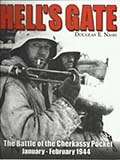Hell's Gate: The Battle of the Cherkassy Pocket - Continue
 "The Germans struggled to get fuel and ammunition to the tank units, which would quickly be immobilized without these critical supplies. Only tanks and other tracked vehicles, in addition to the venerable horse-drawn panje sled, could get through. Trucks, jeeps and motorcycles were either buried up to their fenders in mud or sidelined with mechanical problems." The narrow tracks of the powerful German tanks bogged down, while the Soviets with their tough Lend-Lease Studebaker trucks and wide-tracked tanks fared better.
"The Germans struggled to get fuel and ammunition to the tank units, which would quickly be immobilized without these critical supplies. Only tanks and other tracked vehicles, in addition to the venerable horse-drawn panje sled, could get through. Trucks, jeeps and motorcycles were either buried up to their fenders in mud or sidelined with mechanical problems." The narrow tracks of the powerful German tanks bogged down, while the Soviets with their tough Lend-Lease Studebaker trucks and wide-tracked tanks fared better.
With the Luftwaffe airlift unable to deliver sufficient supplies (just as at Stalingrad), and the relief force stopped so tragically close, the pocketed troops conducted a mass breakout. Instead of Russian hordes, it was German hordes that literally steamrollered the surprised Russians, running a gauntlet of tank and artillery fire in virtually a human wave attack. The initial forces managed to cut their way through, but it was the disorganized mass of troops behind them that felt the wrath of the aroused Soviets. In a scene straight out of Napoleon at Waterloo, Soviet "guns ranging from 7.6 centimeter infantry howitzers to huge 15.2 centimeter howitzers were lined hub to hub, keeping up a steady barrage , often at small groups of men or individual soldiers. Many batteries rolled up the German columns and blasted at point-blank range and were overrun when the desperate enemy charged their positions."
The breakout became a rout, a hellish scene of complete chaos. "Packets of T-34 and JS-IIs [tanks] began to wade into the infantry columns and attack the defenseless troops. Virtually all antitank guns and howitzers had been abandoned at this point, after becoming stuck in the steep ravines or balki that crisscrossed the escape corridor. Thousands of men leapt into snow-filled ditches or ravines to escape from them..."
Incredibly, many Germans did escape, despite Soviet claims to the contrary. The survivors were frozen wrecks, but they were alive. In the end, Nash estimates both sides suffered between sixty and eighty thousand casualties of peace. But it was the Germans who could least afford the slaughter. In addition, two vital panzer corps had been crippled. They were supposed to be the mobile, hard-hitting backbone of the German defense, and their lack would soon be felt as the Soviet relentlessly headed west.
Though not an exciting read, the author's words and plentiful photographs capture the drama and tension of the battle. Nash offers a perceptive analysis of both sides. He credits the Soviets with preparing and executing a solid plan, yet also demonstrates the Red Army's sluggishness in reacting to the breakout. Perhaps the real outcome of Cherkassy was that it set the pattern for the Soviet offensives that broke the back of the Wehrmacht. Deep armored thrusts and wall-to-wall artillery were used here, as well as the technique of lining up armies in deep echelons that would relentlessly assault like waves eroding a sand castle until it crumpled.
Hell's Gate does suffer from the rosy view of Hitler's armies that permeate so many western accounts of the Eastern front. A handful of riflemen or cooks repulse Soviet infantry companies. The SS troops are chivalrous knights, while Russian tanks crush ambulances and troops mow down helpless prisoners. How could it be otherwise, when most of the sources in this book come from German histories and survivor's accounts? The author appears to have made a genuine attempt to interview Russian survivors, while Soviet archives are only slowly seeing the light of day. But a balanced picture would be nice, without the whiff of German supermen versus the Asiatic hordes. It is unnecessary; that so many Germans escaped from the cauldron speak volumes about their skill and valor.
Despite these blemishes, Hell's Gate is a solid, well-researched book that will likely be definitive for years to come. It is a worthy attempt to illuminate a battle that deserves to be better known.